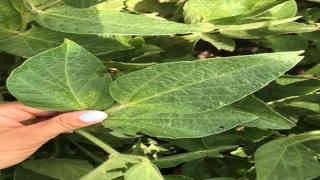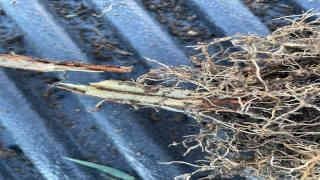By Kriss Nelson
As we enter the last few months of the 2022 growing season, growers should be aware of a few pests beginning to feed on soybeans.
“Western Cherokee County is still part of the extreme drought area, and even though we received a strong four-tenths of rain over the weekend, the dry conditions are typical for spider mites to flare up,” says Johnson.
A sign of spider mite feeding will be yellow spots appearing in the field – particularly in those drought areas.
“Spider mites can be very difficult to find, but you can use a hand lens, phone macro lens, or a white piece of paper and a quick shake of the leaves to look for evidence of the mites,” says Meaghan Anderson, Iowa State University Extension agronomist.
Anderson advises scouting field edges and looking for spider mites feeding on the underside of leaves, creating a stippled appearance to the upper leaf surface and webbing on the underside.

-Check for spider mites on the underlying part of the leaf. (Photo: Meaghan Anderson, Iowa State University field agronomist).
“We are seeing a few small spots in the fields, but since there are some rain chances in the forecast, cooler temperatures predicted and beans in the R5 and R6 stage, no action is warranted at this time for the levels we are seeing,” says Johnson.
"Some insecticides are effective against immature and adult mites, but they are not effective against eggs,” she says. “Several miticides are on the market and are effective against both immature mites and eggs.”
Soybean gall midge
The soybean gall midge is moving from western to central Iowa counties, expanding its territory further into central Iowa with discoveries in soybean fields in western Polk and western Warren counties. This is in addition to other central Iowa in Madison, Dallas and Boone counties.

-The soybean gall midge burrows into the stem of a soybean plant, making it a difficult pest to treat. (Photo: Ryan Johnson, Iowa Soybean Association).
Soybean fields in those areas should be scouted with the most obvious signs of their presence being dead or wilting soybean plants near the edge of fields where corn is adjacent.
Johnson says he identified soybean gall midge while observing dead soybean plants with a live, green plant adjacent.
“I split the stem and found the little red gall midge,” he says. “I also noticed swelling of the soybean stem at the base of the plant. In years past, the stems would easily snap when trying to walk through the gall midge affected area since the larvae burrow through the middle of the stem.”
It is tough to treat the inside of the stem, so there is not a good management option for soybean gall midge at this larvae stage, so we will continue to monitor the spread and significance of the damage.
Click here to see more...